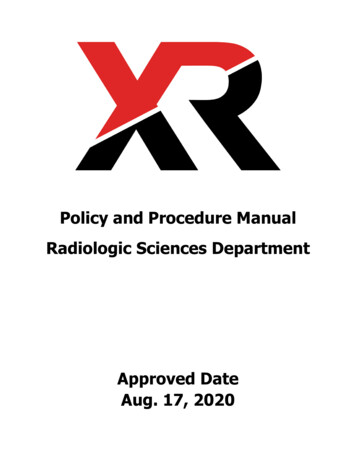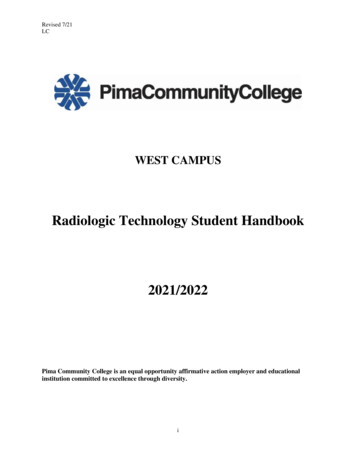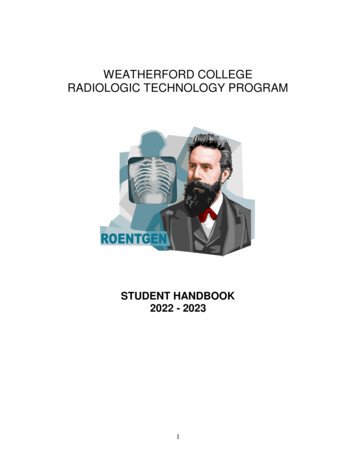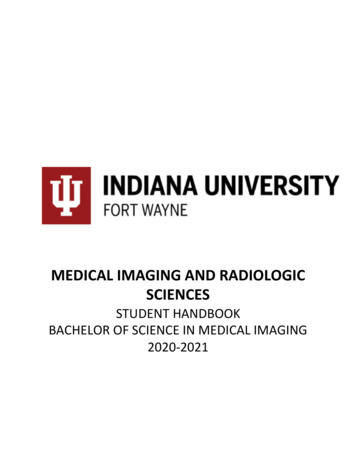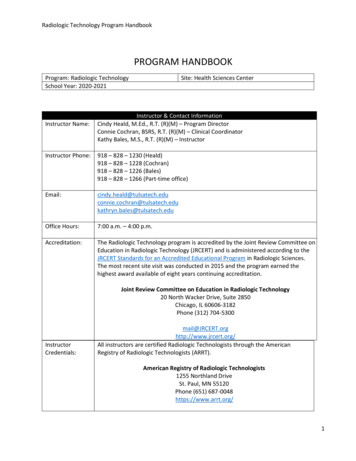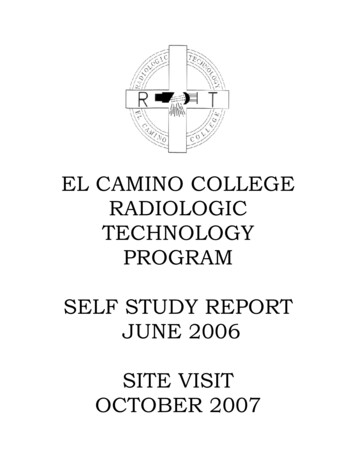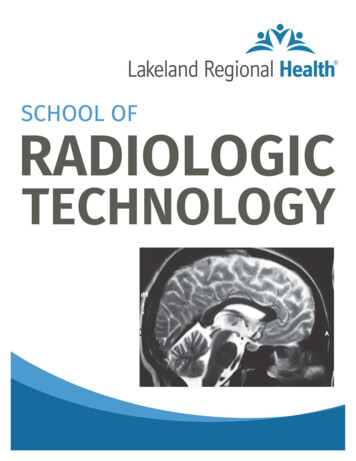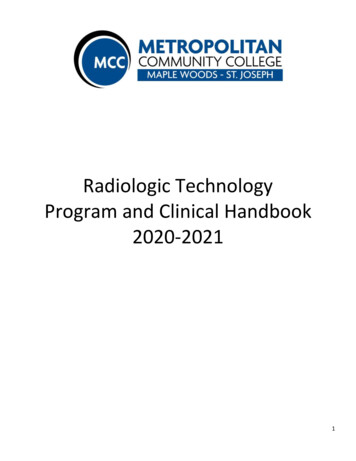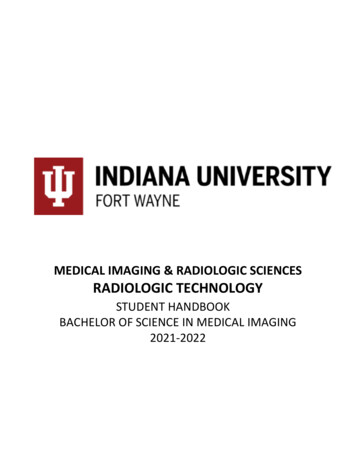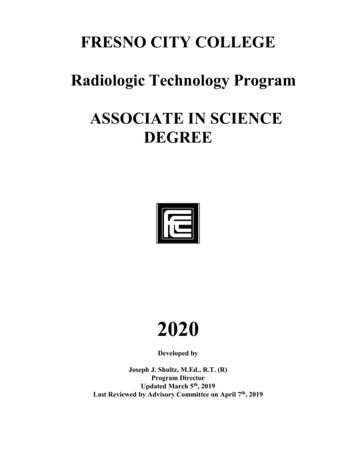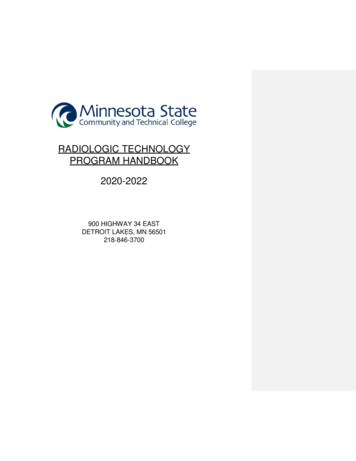
Transcription
RADIOLOGIC TECHNOLOGYPROGRAM HANDBOOK2020-2022900 HIGHWAY 34 EASTDETROIT LAKES, MN 56501218-846-3700
TABLE OF CONTENTSI. College and Program Officials . 1-2II. Mission Statement/Philosophy/Goals/Student Learner Outcomes. 5-7American Society of Radiologic Technologists Code of Ethics . 8-15III. Program Overview. 16Curriculum Description/Program Plan . 17IV. Curriculum Design . 18-19A. Correlation Between Didactic and Clinical InstructionB. Competency DevelopmentV. Clinical Education Plan. 19A. RotationsB. ObjectivesVI. Evaluation Methods . 20-21A. DidacticB. ClinicalC. Summary of Clinical Grade ComponentVII. Progression Standards . 21VIII. Policies. 22-59A. Student Discipline/Termination Policy . 22-25Plan of Action for Written Probation Form. 26Notice of Probation Form . 27Notice of Termination Form . 28B. Student Readmission Policy . 29-31Voluntary Withdrawal Form. 32C. Student Pregnancy Policy . 33-34Declaration of Pregnancy Form . 35D. Clinical Dress Policy . 36-37E. Class Dress Policy . 37F. Smoking Policy . 37-38G. Cell Phone Use Policy . 38H. Student Hlth and Bloodborne Pathogen Exp Control Policy. 39-42I. Attendance Policy . 42-43ii
J. Student Absence Policy . 44-45K. Clinical Absence - Grade Status Policy . 45L. Bereavement Policy . 46M. Student Employment Policy . 46-47N. Student Supervision Policy . 47-49O. Radiation Safety Guidelines/Policy . 49-52P. Background Study Requirements . 53-54Q. Clinical Schedule Policy . 54-55R. Clinical Incident Report Policy . 55-56Incident Report Forms . 57S. Laptop and Internet Requirements . 58T. Compliance with JRCERT Standards Policy . 58-60U. MRI Safety Screening . 60IX. Institutional Policies. 61-62A. Appeals and Grievance ProcedureB. Weather and Emergency Cancellations and ClosingsC. Star Alert SystemD. Student Accident and Health PlanX. Institutional Services . 62A. Academic Guidance and Student CounselingB. Library FacilitiesXI. Handbook Policy Signature Forms . 63-71XII. Clinical Course Outlines . 71-76XIII. Clinical Documents . 77-108A. Weekly BARS Evaluation Forms . 78-91B. Fluoroscopy Evaluation Form . 92C. Modality Rotation Evaluation Form . 93D. Clinical Site Evaluation Form . 94E. Clinical Instructor Evaluation Form . 95F. Student Absence Report Form . 96G. Filling out a Clinical Competency Form Instructions . 97H. Clinical Competency Completion Checklist . 98-102I. ARRT Didactic and Clinical Competency Requirements . 103-108iii
I.College and Program OfficialsM State Administrative PersonnelPresident Minnesota State Community and Technical CollegeDr. Carrie BrimhallDean of Health Sciences, Human Services, and NursingDr. Ken KompelienRadiologic Technology Program Officials and FacultyAnn Bell-Pfeifer M.S .R.T. (R)(M)(QM)Colleen Brady-Santwire M.S R.T (R)(M)Amy Coley B.S R.T (R) (T)Chelsey Nordman R.T. (R)Lana Glover R.T. (R)Program Director/FacultyFacultyClinical CoordinatorM State-Detroit Lakes, MNClinical InstructorEssentia Health-South University, Fargo, ND-56 milesLee Current R.T. (R)(CT)(BD)Madison Hudalla R.T. (R)Clinical InstructorLakewood Health Systems, Staples MN-Staples, MN-71 milesErik Everett R.T. (R)Clinical InstructorAbby Mumm R.T. (R) Lake Region Healthcare Corporation, Fergus Falls, MN-56 milesMelaine Johnson R.T. (R)(CT)Clinical InstructorPerham Health, Perham, MN-29 milesSarah Oelfke R.T. (R)Clinical InstructorEssentia Health-St Mary’s, Detroit Lakes, MNBrianna Wegner R.T. (R)(M)CT)Clinical InstructorTri County Hospital, Wadena, MN-54 milesHeather Kashmark R. T. (R)(CT)Clinical InstructorDavid Jacobsen R.T. (R)(CT)Veteran’s Affairs Medical Center, Fargo, ND-56 milesApril Andrew R.T. ( R)Clinical InstructorHeartland Orthopedic Clinic, Alexandria, MN-81 miles1
Radiologic Technology Program Officials and Faculty(Continued)Renelle Kunkel R.T.(R)Chelsy Tangen R.T. (R)Clinical InstructorEssentia Health, Fargo, ND-56 milesTiera Opatz R.T. (R)(M)(CT)Jennifer Klaphake R.T. (R)(CT)Clinical InstructorCHI Lisbon Health, Lisbon, ND-121 milesClinical InstructorCentra Care, Sauk Centre, MN-108 milesClinical InstructorGlacial Ridge Health System ,Glenwood, MN-105 milesMark Gorres R.T.(R)(CT)Brianna Varnum R.T.(R)Rachel Skoog R.T. (R)Clinical InstructorEssentia Health, Park Rapids, MN-39 milesErin Haanen-Biel R. T. (R)Clinical InstructorCoteau Des Prairies Hospital and Clinic, Sisseton, SD-133 milesRebecca Meisner R.T.(R)(M)(CT)Heidi Earl R.T.(R) (CT)Erika Zavada R.T. (R)Jennifer Magnine R.T. (R)Clinical InstructorHennepin County Medical Center, Minneapolis, MN-208 milesLacy Majerus R.T. (R)(CT)Jordyn Steffes R.T. (R)Clinical InstructorSanford Medical Center, Bemidji, MNSanford Clinic Anne St., Bemidji, MN-83 milesFormatted: Not StrikethroughClinical InstructorSanford Health, Valley City, ND-118 milesClinical InstructorWhite Earth, Ogema, MN-18 milesCarli Thompson R.T.(R)Lisa Stark R.T. (R)(M)Kyle Henry, R. T. (R)Clinical InstructorSanford Mayville, ND-109 milesClinical InstructorAlexandria Clinic, Alexandria MN-88 milesClinical InstructorCHI, Park Rapids, MN- 39 miles2
Gail Burner, R.T. (R)Clinical InstructorEssentia Health 52nd Ave, Fargo, ND-60 milesAustin Walker, R.T. (R)Clinical InstructorEssentia Health West Acres, Fargo, ND- 60 milesKendra Asket, R.T. (R)(M)Clinical InstructorEssentia Health Wahpeton, ND- 103 miles*Numbers per site note the mileage from the Detroit Lakes campus to clinical sites.Students may be assigned to any clinical site listed for clinical rotations.Revised: 05/17/20223
II. Mission Statement, Philosophy, Goals and Student Learner OutcomesMISSION STATEMENTThe Radiologic Technology program at Minnesota State Community and Technical College isdesigned to create a rich academic environment using multiple delivery formats and to providequality didactic and clinical education enhanced with innovative learning strategies whichensure graduates have the required knowledge and skills necessary to begin their careers asentry-level radiologic technologists.PHILOSOPHYRadiologic technology is a profession dedicated to assisting radiology and other medicaldisciplines toward the common goal of alleviating human suffering. A systematic process ofeducation is required for equipping qualified individuals to become competent, contributingmembers of this profession. This educational process requires correlation of didactic,clinical and laboratory learning into a well-rounded, understandable and rewardingprocess. It must provide opportunities for acquiring personal competencies as well asunderstanding of the overall responsibilities of providing health care services. The personnelassociated with this program are dedicated to assisting qualified individuals to becomecompetent, capable and caring members of this profession.GOALSGOAL 1Graduates will have entry-level skills for employment in radiologic technology. Practice radiation protection for patient, self and others by applying the concepts ofALARA. Apply positioning skills. Demonstrate patient care skills.GOAL 2Graduate students who use problem solving and critical thinking skills to producequality images. Exercise independent judgment in areas of exposure factor manipulations involving alltechnical factors and equipment for procedures routinely performed in the clinicalsetting. Evaluate radiographs for appropriate anatomy positioning and image quality.GOAL 3Graduate students with professional and life-long learning attitudes. Conduct him/herself in a professional manner and abide by the Code of Ethics asoutlined by the ASRT/ARRT. Evaluate the value of professional advancements.GOAL 4Graduate students who possess and demonstrate effective communication skills. Communicate effectively in both medical and professional relationships.Program Effectiveness Goals5
Graduate from a Joint Review Committee on Education in Radiologic Technology(JRCERT) accredited program.Possess the knowledge and skills employers seek to hire.MINNESOTA STATE COMMUNITY AND TECHNICAL COLLEGERADIOLOGIC TECHNOLOGY PROGRAMLEARNER OUTCOMES - DETROIT LAKES CAMPUSThe following student learning outcomes are specific program outcomes which are expressedin the program goals. These outcomes are assessed through graduate and employer surveyson an annual basis. These outcomes are specific to the courses taught within the 27-monthprogram.Graduates of the Radiologic Technology program will:1.Communicate effectively in both medical and professional relationships.a. Treat all patients with compassion and empathy.b. Adapt to individual diversities.c. Use effective and correct verbal and written communication.d. Receive, organize, prioritize and transmit information.e. Recognize and respond to verbal and nonverbal communications.f. Adapt communications to an individual’s ability to understand.g. Use medical terminology effectively.2.Demonstrate patient care skills.a. Provide instructions to patients, families and other health care providers.b. Communicate with patients, staff and physicians in a polite and respectful manner.3.Apply positioning skills.a. Properly position patients for routine exams.b. Assess patient’s condition and determine when an adjustment from routineguidelines is necessary.c. Use appropriate devices to aid in positioning.d. Demonstrate confidence in his/her clinical skills.4.Exercise independent judgment in areas of exposure factor manipulationsinvolving all technical factors and equipment for procedures routinely performedin the clinical setting.a. Demonstrate an understanding of the difference between AEC and manualtechniques.b. Comprehend and apply knowledge of different image receptor types, grid/non-gridtechniques when selecting exposure factors.c. Comprehend and apply knowledge of how distance affects exposure factors.5.Evaluate radiographs for appropriate anatomy, positioning and image quality.a. Take pride in producing high-quality radiographs.b. Identify when technical factors necessitate a repeat exam.6
c. Demonstrate the ability to manipulate exposure factors appropriately.d. Identify when positioning is inadequate. Correct positioning by making necessaryadjustments to produce a quality image.6.Conduct him/herself in a professional manner and abide by the Code of Ethics asoutlined by the ASRT/ARRT.a. Wear required uniform including name tag and rad badge, and be neat inappearance.b. Demonstrate a desire for success and accept constructive criticism.c. Follow federal, state and local legal guidelines.d. Comply with risk management and safety procedures.e. Maintain confidentiality.f. Uphold high ethical standards.7.Practice radiation protection for patients, self and others by applying theconcepts of ALARA.a. Use gonadal shielding when appropriate.b. Inquire of possible pregnancy when appropriate.c. Use collimation when possible.d. Provide/wear protective lead apparel when appropriate.8.Evaluate the value of professional advancements.a. Recognize professional credentialing criteria.9.Graduate from a Joint Review Committee on Education in Radiologic Technologyaccredited program.a. See all previous indicators.10.Possess the knowledge and skills employers seek in hiring qualified radiologictechnologists.a. See all previous indicators.7
AMERICAN SOCIETY OF RADIOLOGIC TECHNOLOGISTSCODE OF ETHICS The radiologic technologist conducts himself or herself in a professional manner,responds to patient needs and supports colleagues and associates in providing qualitypatient care. The radiologic technologist acts to advance the principal objective of the profession toprovide services to humanity with full respect for the dignity of mankind. The radiologic technologist delivers patient care and service unrestricted by concernsof personal attributes or the nature of the disease or illness, and without discriminationon the basis of sex, race, creed, religion or socio-economic status. The radiologic technologist practices technology founded upon theoreticalknowledge and concepts, uses equipment and accessories consistent with thepurpose for which they were designed, and employs procedures and techniquesappropriately. The radiologic technologist assesses situations; exercises care, discretion andjudgment; assumes responsibility for professional decisions; and acts in the bestinterest of the patient. The radiologic technologist acts as an agent through observation andcommunication to obtain pertinent information for the physician to aid in thediagnosis and treatment of the patient and recognizes that interpretation anddiagnosis are outside the scope of practice for the profession. The radiologic technologist uses equipment and accessories, employs techniquesand procedures, performs services in accordance with an accepted standard ofpractice and demonstrates expertise in minimizing radiation exposure to the patient,self and other members of the health care team. The radiologic technologist practices ethical conduct appropriate to the profession andprotects the patient’s right to quality radiologic technology care. The radiologic technologist respects confidences entrusted in the course of professionalpractice, respects the patient's right to privacy, and reveals confidential information onlyas required by law or to protect the welfare of the individual or the community. The radiologic technologist continually strives to improve knowledge and skills byparticipating in continuing education and professional activities, sharing knowledge withcolleagues and investigating new aspects of professional practice.8
objective of the profession to provide services tohumanity with full respect for the dignity of mankind.3.The radiologic technologist delivers patient care andservice unrestricted by the concerns of personalattributes or the nature of the disease or illness, andwithout discrimination on the basis of sex, race, creed,religion, or socio-economic status.4.The radiologic technologist practices technologyfounded upon theoretical knowledge and concepts,uses equipment and accessories consistent with thepurposes for which they were designed, and employsprocedures and techniques appropriately.ARRT STANDARDS OFETHICSLast Revised: September 1, 2017Published: September 1, 2017PREAMBLEThe Standards of Ethics of The American Registry of Radiologic5.Technologists (ARRT) shall apply solely to persons holdingcertificates from ARRT that are either currently certified andregistered by ARRT or that were formerly certified andregistered by ARRT (collectively, “Certificate Holders”), and topersons applying for certification and registration by ARRT in 6.order to become Certificate Holders (“Candidates”). RadiologicTechnology is an umbrella term that is inclusive of the disciplinesof radiography, nuclear medicine technology, radiation therapy,cardiovascular-interventional radiography, mammography,computed tomography, magnetic resonance imaging, qualitymanagement, sonography, bone densitometry, vascularsonography, cardiac-interventional radiography, vascular7.interventional radiography, breast sonography, and radiologistassistant. The Standards of Ethics are intended to be consistentwith the Mission Statement of ARRT, and to promote the goalsset forth in the Mission Statement.STATEMENT OF PURPOSEThe purpose of the ethics requirements is to identify individuals8.who have internalized a set of professional values that causeone to act in the best interests of patients. This internalization ofprofessional values and the resulting behavior is one element ofARRT’s definition of what it means to be qualified. Exhibiting9.certain behaviors as documented in the Standards of Ethics isevidence of the possible lack of appropriate professional values.The radiologic technologist assesses situations;exercises care, discretion, and judgment; assumesresponsibility for professional decisions; and acts in thebest interest of the patient.The radiologic technologist acts as an agent throughobservation and communication to obtain pertinentinformation for the physician to aid in the diagnosis andtreatment of the patient and recognizes thatinterpretation and diagnosis are outside the scope ofpractice for the profession.The radiologic technologist uses equipment andaccessories, employs techniques and procedures,performs services in accordance with an acceptedstandard of practice, and demonstrates expertise inminimizing radiation exposure to the patient, self, andother members of the healthcare team.The radiologic technologist practices ethical conductappropriate to the profession and protects the patient’sright to quality radiologic technology care.The radiologic technologist respects confidencesentrusted in the course of professional practice,respects the patient’s right to privacy, and revealsconfidential information only as required by law or toprotect the welfare of the individual or the community.The Standards of Ethics provides proactive guidance on what itmeans to be qualified and to motivate and promote a culture ofethical behavior within the profession. The ethics requirements10. The radiologic technologist continually strives tosupport ARRT’s mission of promoting high standards of patientimprove knowledge and skills by participating incare by removing or restricting the use of the credential by thosecontinuing education and professional activities,who exhibit behavior inconsistent with the requirements.sharing knowledge with colleagues, and investigatingnew aspects of professional practice.A. CODE OF ETHICSThe Code of Ethics forms the first part of the Standards of Ethics.B. RULES OF ETHICSThe Code of Ethics shall serve as a guide by which CertificateThe Rules of Ethics form the second part of the StandardsHolders and Candidates may evaluate their professional of Ethics. They are mandatory standards of minimallyconduct as it relates to patients, healthcare consumers,acceptable professional conduct for all Certificate Holdersemployers, colleagues, and other members of the healthcareand Candidates. Certification and Registration are methodsteam. The Code of Ethics is intended to assist Certificateof assuring the medical community and the public that anHolders and Candidates in maintaining a high level of ethicalindividual is qualified to practice within the profession.conduct and in providing for the protection, safety, and comfortBecause the public relies on certificates and registrationsof patients. The Code of Ethics is aspirational.issued by ARRT, it is essential that Certificate Holders andCandidates act consistently with these Rules of Ethics.1. The radiologic technologist acts in a professional manner,These Rules of Ethics are intended to promote theresponds to patient needs, and supports colleagues andprotection, safety, and comfort of patients. The Rules ofassociates in providing quality patient care.Ethics are enforceable. R.T.s are required to notify ARRTof any ethics violation, including state licensing issues and2. The radiologic technologist acts to advance the principalcriminal charges and convictions, within 30 days of the9
occurrence or during their annual renewal of certification andregistration, whichever comes first. Applicants for certificationand registration are required to notify ARRT of any ethicsviolation, including state licensing issues and criminal chargesand convictions, within 30 days of the occurrence.Certificate Holders and Candidates engaging in any of thefollowing conduct or activities, or who permit the occurrence ofthe following conduct or activities with respect to them, haveviolated the Rules of Ethics and are subject to sanctions asdescribed hereunder:The titles and headings are for convenience only, and shall notbe used to limit, alter or interpret the language of any Rule.Fraud or Deceptive Practices1.2.3.Fraud Involving Certification and RegistrationEmploying fraud or deceit in procuring or attempting toprocure, maintain, renew, or obtain or reinstate certificationand registration as issued by ARRT; employment inradiologic technology; or a state permit, license, orregistration certificate to practice radiologic technology.This includes altering in any respect any document issuedby ARRT or any state or federal agency, or by indicating inwriting certification and registration with ARRT when that isnot the case.Fraudulent Communication Regarding CredentialsEngaging in false, fraudulent, deceptive, or misleadingcommunications to any person regarding the ience,orqualifications, or the status of the individual’s state permit,license, or registration certificate in radiologic technology orcertificate of registration with ARRT.Fraudulent Billing PracticesKnowingly engaging or assisting any person to engage in,or otherwise participating in, abusive or fraudulent billingpractices, including violations of federal Medicare andMedicaid laws or state medical assistance laws.Subversion4.assessment information that uses language that issubstantially similar to that used in questions and/oranswers on ARRT examinations or CQR assessmentsfrom an examinee, or a CQR participant, whetherrequested or not; and/or(iii) copying, publishing, reconstructing (whether bymemory or otherwise), reproducing or transmitting anyportion of examination and/or CQR assessmentmaterials by any means, verbal or written, electronic ormechanical, without the prior express writtenpermission of ARRT or using professional, paid orrepeat examination takers and/or CQR assessmentparticipants, or any other individual for the purpose ofreconstructing any portion of examination and/or CQRassessment materials; and/or(iv) using or purporting to use any portion ofexamination and/or CQR assessment materials thatwere obtained improperly or without authorization forthe purpose of instructing or preparing any Candidatefor examination or participant for CQR assessment;and/or(v) selling or offering to sell, buying or offering to buy,or distributing or offering to distribute any portion ofexamination and/or CQR assessment materialswithout authorization; and/or(vi) removing or attempting to remove examinationand/or CQR assessment materials from anexamination or assessment room; and/or(vii) having unauthorized possession of any portion ofor information concerning a future, current, orpreviously administered examination or CQRassessment of ARRT; and/or(viii) disclosing what purports to be, or what you claimto be,or under all circumstances is likely to beunderstood by the recipient as, any portion of or“inside” information concerning any portion of a future,current, or previously administered examination orCQR assessment of ARRT; and/or(ix) communicating with another individual duringadministration of the examination or CQR assessmentfor the purpose of giving or receiving help in answeringexamination or CQR assessment questions, copyinganother Candidate’s, or CQR participant’s answers,permitting another Candidate or a CQR participant tocopy one’s answers, or possessing unauthorizedmaterials including, but not limited to, notes; and/or(x) impersonating a Candidate, or a CQR participant,or permitting an impersonator to take or attempt to takethe examination or CQR assessment on one’s ownbehalf; and/or(xi) using any other means that potentially alters theresults of the examination or CQR assessment suchthat the results may not accurately represent theprofessional knowledge base of a Candidate, or a CQRparticipant.Examination / CQR SubversionSubverting or attempting to subvert ARRT’s examinationprocess, and/or the structured self-assessments that arepart of the Continuing Qualifications Requirements (CQR)process. Conduct that subverts or attempts to subvertARRT’s examination and/or CQR assessment processincludes, but is not limited to:(i) disclosing examination and/or CQR assessmentinformation using language that is substantially similar tothat used in questions and/or answers from ARRTexaminations and/or CQR assessments when suchCE Subversioninformation is gained as a direct result of having been an5. Subverting, attempting to subvert, or aiding others toexaminee or a participant in a CQR assessment or havingsubvert or attempt to subvert ARRT’s Continuingcommunicated with an examinee or a CQR participant; thisEducation (CE) Requirements, and/or ARRT’sincludes, but is not limited to, disclosures to students inContinuing Qualifications Requirements (CQR).educational programs, graduates of educational programs,Conduct that subverts or attempts to subvert ARRT’seducators, anyone else involved in the preparation ofCE or CQR Requirements includes, but is not limitedCandidates to sit for the examinations, or CQR participants;to:and/or(i) providing false, inaccurate, altered, or deceptive(ii) soliciting and/or receiving examination and/or CQR10
information related to CE or CQR activities to ARRT or anARRT recognized record keeper; and/or(ii) assisting others to provide false, inaccurate, altered, ordeceptive information related to CE or CQR activities toARRT or an ARRT recognized recordkeeper; and/or(iii) conduct that results or could result in a false or deceptivereport of CE or CQR completion; and/or(iv) conduct that inany way compromises the integrity of the CE or CQRRequirements such as sharing answers to the post-tests orself-learning activities, providing or using false certificatesof participation, or verifying credits that were not earned.6.Failure to Cooperate with ARRT InvestigationSubverting or attempting to subvert ARRT’s certificationand registration processes by:(i) making a false statement or knowingly providing falseinformation to ARRT; or(ii) failing to cooperate with any investigation by ARRT.Unprofessional ConductFailure to Conform to Minimal Acceptable StandardsEngaging in unprofessional conduct, including, but notlimited to:(i) a departure from or failure to conform to applicable federal,state, or local governmental rules regarding radiologictechnology practice or scope of practice; or, if no such ruleexists, to the minimal standards of acceptable andprevailing radiologic technology practice;(ii) any radiologic technology practice that may createunnecessary danger to a patient’s life, health, or safety.Actual injury to a patient or the public need not beestablished under this clause.Improper Delegation or Acceptance of a Function12. Delegating or accepting the delegation of a radiologictechnology function or any other prescribedhealthcare function when the delegation oracceptance could reasonably be expected to createan unnecessary danger to a patient’s life, health, orsafety. Actual injury to a patient need not beestablished under this clause.Fitness to PracticeActual or Potential Inability to Practice13. Actual or potential inability to practice radiologictechnology with reasonable skill and safety to patientsby reason of illness; use of alcohol, drugs, chemicals,or any other material; or as a result of any mental orphysical condition.Inability to Practice by Judicial Determination14. Adjudication as mentally incompetent, mentally ill,chemically dependent, or dangerous to the public, by acourt of competent jurisdiction.7.Improper Management of Patient RecordsFalse or Deceptive Entries15. Improper management of patient records, includingfailure to maintain adequate patient records or tofurnish a patient record or report required by law; ormaking, causing, or permitting anyone to make false,deceptive, or misleading entry in any patient record.16.Failure to Protect Confidential Patient In
radiologic technology program handbook 2020-2022. 900 highway 34 east detroit lakes, mn 56501 218-846-3700
